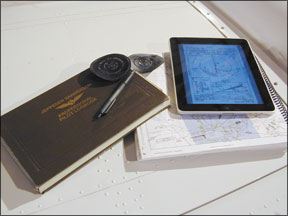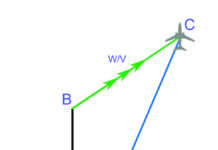November 12345, cross 20 southeast of the Nashville VOR at 4000….” “Maintain best speed to the outer marker….” “Hold as published, expect further clearance at one-five past the hour….” “Radar contact lost, intercept Victor 509, report crossing NXTFX intersection….” “November 12345, an amendment to your direct clearance; fly heading 220 degrees to intercept the OKC 355 radial, then cleared 288 to the OKC 30 DME fix, thence inbound on the Pioneer VOR 195 direct Pioneer, Victor 77 Wichita, direct….” Most IFR routings in the continental U.S. are fairly easy. More and more its GPS-direct to a visual, ILS or GPS approach. Meanwhile, a great many of us have regular routes we usually fly and-after a few laps around that course-we can fly the trip and even the approach without having to look at a chart. And yet, we may always be responsible for complying with a change in our expectations (or clearance). Every one of the quoted ATC instructions above was something I received unexpectedly at one time or another while flying a “familiar” instrument routing. Further, ATC procedures have a definite regional quality to them. Go out of your region and you may not be up to speed on whats “normal” for IFR pilots there. Further, any number of instrument failures, loss of GPS signal, electrical malfunctions, or loss of instrument air or vacuum can make even a familiar IFR environment suddenly unfamiliar to you. Consequently, even if you fly a lot of IFR, you need to do some sort of regular training to remain current on procedures you dont regularly fly, but could be asked of you at any time. Barely legal The FAAs FAR 61.57 tells us what we need to legally fly as pilot in command on an instrument flight plan (whether or not we actually enter instrument meteorological conditions (IMC)). Theres not much to it-within the preceding six months you must have logged at least: –Six instrument approaches. This experience must be in “actual” or “simulated” IMC, i.e., flying with a view-limiting device with a safety pilot or CFI. The approaches can be a combination of precision and non-precision procedures, but if you elect, it can be the same approach flown six different times. If you elect to use an approved training device (ATD, a “simulator”) for IFR currency there are some additional requirements: -The ATD time must include three hours of simulated IFR flight in the previous two months. -The sim time must include two unusual attitude recoveries while in a descending, V
-Holding procedures and tasks.
-Intercepting and tracking courses through the use of navigational electronic systems.
Thats all.
If you dont log even this minimal amount of experience in six-months time, you can find a qualified safety pilot and fly the minimum to re-set your IFR currency counter. You can also do this with an instructor, or (with an instrument instructor) you can log the tasks performed while using an approved training device. Its only after a full year that you cant become IFR current by simply logging six approaches, tracking and holding. In that case, you need an instrument proficiency check, or IPC.
The IPC
FAR 61.57 also tells us whats needed if a pilot does not meet the minimum IFR currency requirements. What many pilots (and instructors) dont seem to know, is specific tasks must be flown before an IPC is considered successfully completed. According to the regulation, an “instrument proficiency check…consists of the areas of operation and instrument tasks required in the instrument rating practical test standards.” In other words, the days of flying just whatever the CFI-I thinks is “representative” of the skills needed to fly IFR are long past.
Further, unless youve had a really bad year, you probably have not experienced instrument failures, electrical outages, engine power loss or primary navigation outages since your last IPC. You probably havent dealt with the entire gamut of crossing restrictions, high-speed approaches, en route re-routes or other oddities. Your IPC is a great time to request the instructor teach you some of these things before you face them alone in the clouds.
A good IPC should be more than just a “check” to see if you are capable of flying to PTS tolerances. It should be crafted to evaluate where you are now, and teach you just a little bit more to increase your instrument acumen. Your goal should not be to simply demonstrate your current capability and get a “youre okay” endorsement in your pilots logbook. You should really learn something.
Avoiding The IPC
First though, lets explore the $64,000 question: Why do you need an IPC? If youre an active pilot, getting out and flying off the requirements-as long as youre within a year of your last IPC, or within six months of the last time you were instrument-current-allows you to avoid the IPC. Whether avoiding it is the best choice for you is another discussion, but you dont need an IPC after obtaining the required recent experience. Especially if all you need is a couple of approaches or some holds, grabbing a safety pilot and knocking them out solves the problem.
On the other hand, if youre on the cusp of needing an IPC, theres something else going on: Either you havent flown much lately at all, or you havent flown much IFR lately. In either case, you need to get out more. Use the following suggestions to help you stay current and eliminate the need for an IPC.
Keeping these in mind when “on a mission” will help keep your skills honed.
Fly as much “actual” as you can. Dont be afraid to fly trips in the clouds, so long as the weather isnt beyond your or the airplanes capability. File and fly cross-country trips on an instrument flight plan, even in good weather. Think of flying IFR like speaking a foreign language-the more you practice, the better youll get.
Mix it up. Dont always rely on an autopilot to fly your approach. If your airplane has the capability, alternate between autopilot-coupled, hand-flown flight director and raw-data hand-flown approaches. Remain proficient in all three techniques. Dont always ask for the ILS or the GPS approach if the weather is good enough for other types. If your operations are usually GPS direct, file and fly an airways flight, especially if your GPS does not automatically route using airways. Most of us get pretty good at a narrow range of our airplanes capabilities. Actively look for “other” ways you can use the resources available on your panel.
Keep a new CFI-I off the streets. Make your instrument education a progressive event, one to educate you as well as the instructor. Hire a young CFI-I every couple of months and take him/her along on one of your regularly scheduled trips to log “hood time” along the way. You may be surprised even a “newbie” CFI-I has something to teach you-after all, he or she just survived the FAA writtens and the practical test! Consider the instructors fee your investment in the future of aviation safety.
Fly with a safety pilot. Take a friend along. If he/she is current and qualified to act as pilot-in-command of the airplane youre flying, he or she is also qualified to be a “safety pilot.” Put your friend in the right seat to watch for terrain and obstructions, and don your favorite view-limiting device. Trade off and offer safety pilot services to your friend in return, and learn from the way he or she does things.
Practice contingencies. With your CFI-I or safety pilot, include partial panel operations, missed approaches and holds, and GPS failure.
Use simulators and flight training devices. Most personal aircraft pilots dont have access to or cant afford to fly in “true” flight simulators. Approved training devices (ATDs), however, adorn many an FBO, and can be used for much less than the cost of an hour in an airplane. Desktop computerized versions are available as well. Even unofficial time in an ATD or a computerized flight simulation “game” can do wonders to keep your instrument scan sharp.
Use IFR Skills on VFR Flights. Demanding precision from yourself, even in visual weather. Hold altitudes within 20 feet, and headings within two degrees (come on, you can do it!). Use constant-rate or constant-airspeed climbs and descents, and precise, standard-rate turns. Track your course guidance, be it GPS, VOR or simple deduced reckoning, with the same discipline you need in IMC. Use flight following to keep your radio skills honed. Fly the approach into your destination airport-youre up there already, so the cost of the extra time is minimal. Dont forget to watch outside for other traffic, just like you must “see and avoid” when flying IFR in visual conditions.
The Next Level
For an instrument-rated pilot, a real way of further minimizing the risk of IFR operations is to go well beyond the minimum requirements for instrument currency. Theres too much at stake to short-cut the skills you need to remain IFR current and to be ready to handle what ATC or airplanes systems throw at you. Remember: The requirements of FAR 61.57 are just minimum standards for safety.
Instead, look at your next IPC as an opportunity to expand your margin of safety, so youll never find yourself behind the airplane when asked to fly an unusual-for-you instrument procedure or clearance. Make a list of what you want to learn, and ask your CFI-I to develop a syllabus to teach from that list. Then prepare yourself beforehand, to get the maximum benefit from your IPC.
Tom Turner is a CFII-MEI who frequently writes and lectures on aviation safety.



